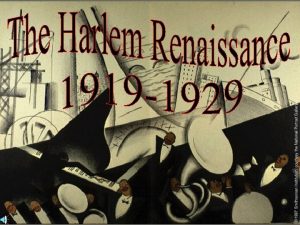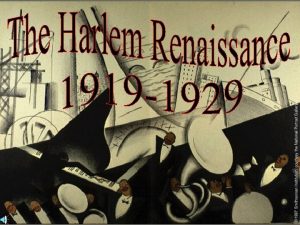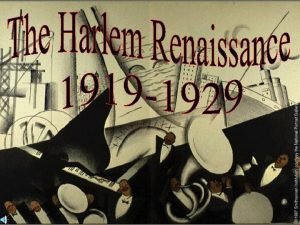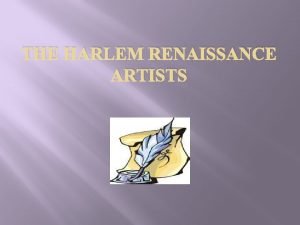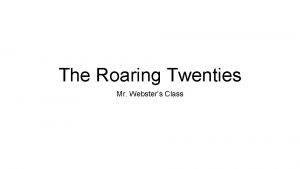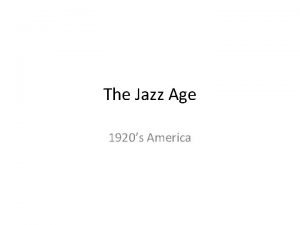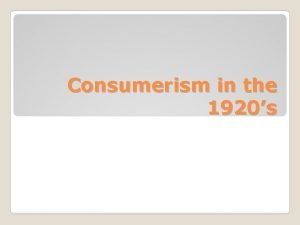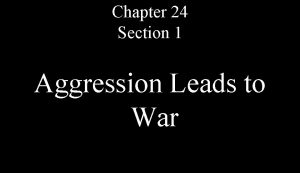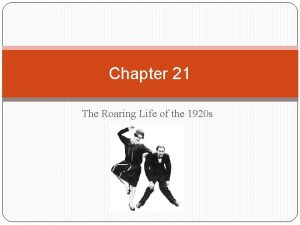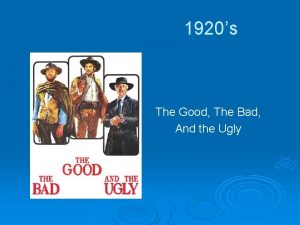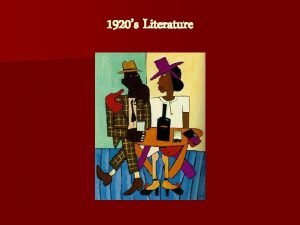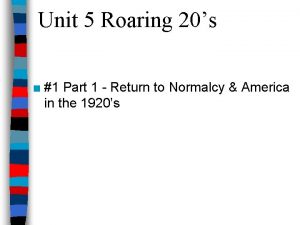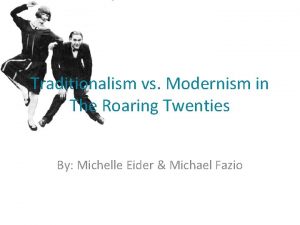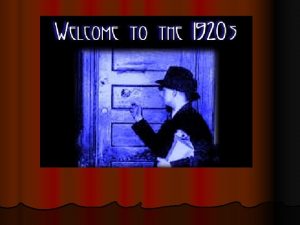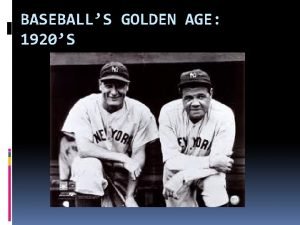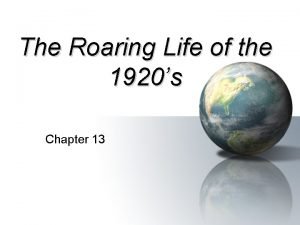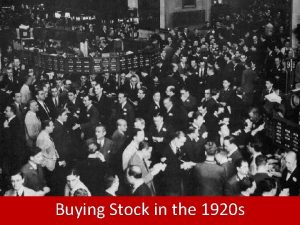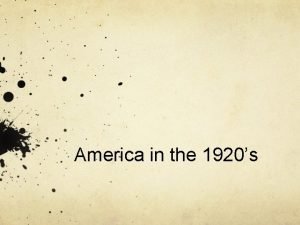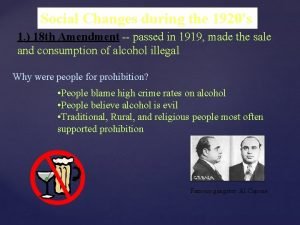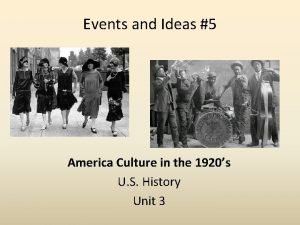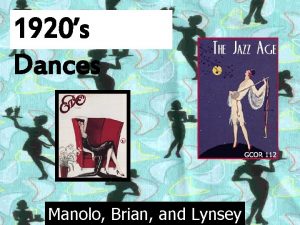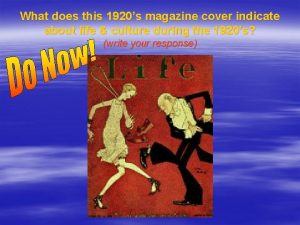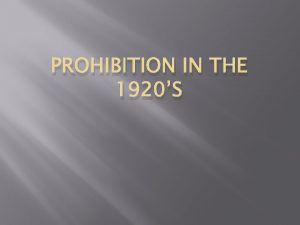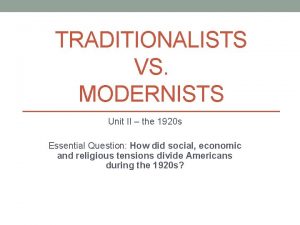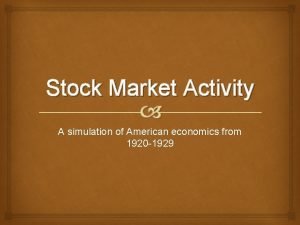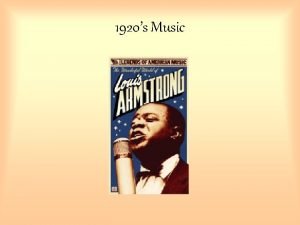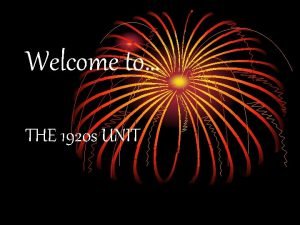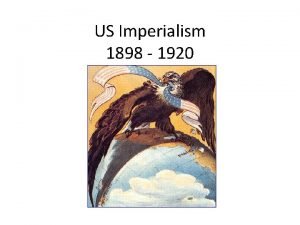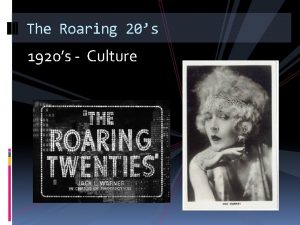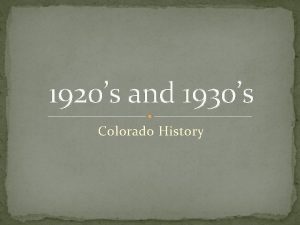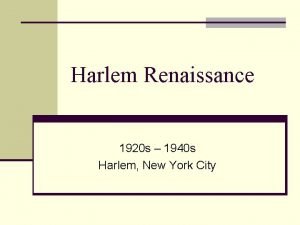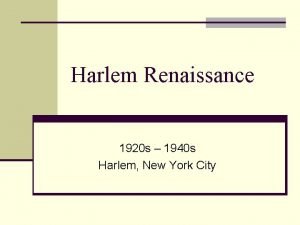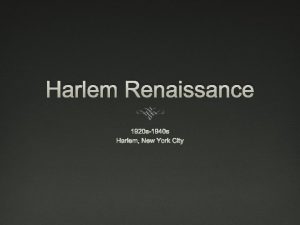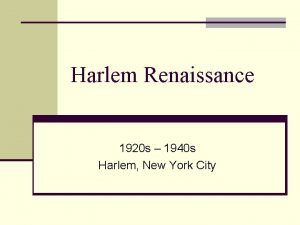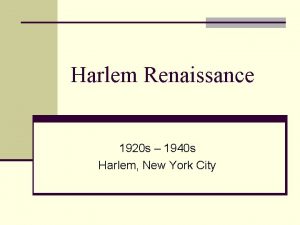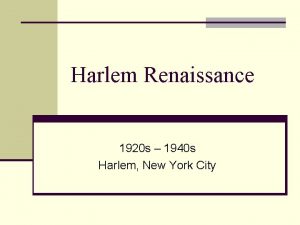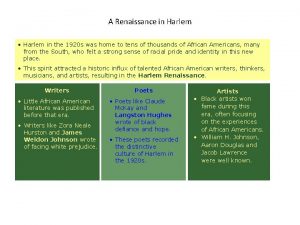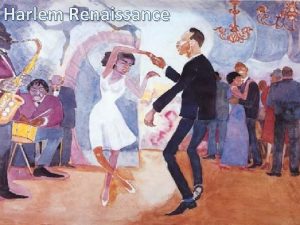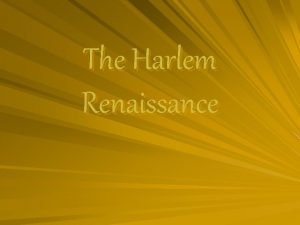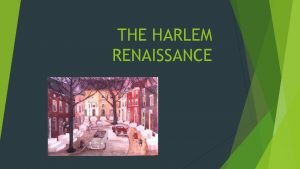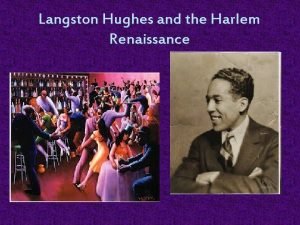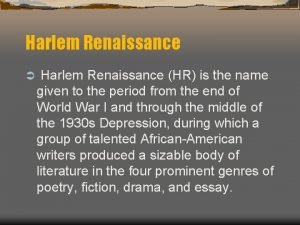Map of Harlem 1920s In the early 1920































- Slides: 31


Map of Harlem – 1920’s

• In the early 1920 s, African American artists, writers, musicians, and performers were part of a great cultural movement known as the Harlem Renaissance. • The huge migration to the North after World War I brought African Americans of all ages and walks of life to the thriving New York City neighborhood called Harlem. • Doctors, singers, students, musicians, shopkeepers, painters, and writers, congregated, forming a vibrant mecca of cultural affirmation and inspiration.

Art from the Harlem Renaissance Jeunesse by Palmer Hayden Street Life, Harlem, by William H. Johnson

Langston Hughes wrote, “Harlem was in vogue. ” Black painters and sculptors joined their fellow poets, novelists, actors, and musicians in a creative outpouring that established Harlem as the international capital of Black culture. Langston Hughes 1902 -1967

Zora Neale Hurston was remarkable in that she was the most widely published black woman of her day. She authored more than fifty articles and short stories as well as four novels, two books on folklore, an autobiography, and some plays. At the height of her success she was known as the “Queen of the Harlem Renaissance. ” Zora Neale Hurston 1891 -1960 American writer

In 1925, at the height of the jazz era in Paris, the sensational cast of musicians and dancers from Harlem, assembled as La Revue Negre, exploded on the stage of the Theatre des Champs Elysees. Its talented young star, Josephine Baker (1906 -1975), captivated audiences with a wild new dance called the Charleston.

“Louis Armstrong’s station in the history of jazz is unimpeachable. If it weren’t for him, there wouldn’t be any of us. ” Dizzy Gillespie, 1971

Duke Ellington 1899 -1974 Duke Ellington brought a level of style and sophistication to Jazz that it hadn't seen before. By the time of his passing, he was considered amongst the world’s greatest composers and musicians.

James Van Der Zee 1886 -1983 Couple, Harlem 1933 silver print photograph

The visual art of the Harlem Renaissance was an attempt at developing a new African. American aesthetic in the fine arts. Believing that their life experiences were valuable sources of material for their art, these artists created an iconography of the Harlem Renaissance era. Thematic content included Africa as a source of inspiration, African-American history, folk idioms, (music and religion of the South), and social injustice.

Meta Vaux Warrick Fuller Sculptor 1877 -1968 Meta Warrick Fuller was a sculptor who looked to the songs of black Americans and to African folk tales for inspirational themes that focused on pathos and joy in the human condition. She introduced these subjects to America long before the Harlem Renaissance.

This sculpture by Meta Warrick Fuller, anticipated the spirit and style of the Harlem Renaissance by symbolizing the emergence of the New Negro. Fuller said she was thinking about the average African-American, whom she envisioned “awakening, gradually unwinding the bondage of his past and looking out on life again, expectant and unafraid. ” The Awakening of Ethiopia 1914

Henry Ossawa Tanner The Banjo Lesson, 1893 Tanner wanted to show a positive image of the African-American by highlighting the sense of dignity and in the touching moment of the elder teaching the boy how to play the banjo. Tanner also chose the banjo because of its African origin and its being the most popular musical instrument used by the slaves in early America

Aaron Douglas 1898 -1979 “I refuse to compromise and see blacks as anything less than a proud and majestic people. ” Window Cleaning, 1935

William H. Johnson Street-life Harlem

William H. Johnson 1901 -1970 Chain Gang. 1939 Johnson arrived in Harlem when the Renaissance was in the making. While there he created several paintings that dealt with political and social Harlem. Chain Gang is one example.

William H. Johnson Swing Low, Sweet Chariot 1939 Johnson always showed great devotion to painting themes that celebrated Black Christianity. This painting is an example of one based on a literal interpretation of a spiritual occasion.

Palmer Hayden, The Janitor Who Paints, 1937 In this symbolic selfportrait, Hayden is at work in his basement studio, surrounded by the tools of his dual professions, a palette, brushes and easel, and a garbage can, broom, and feather duster. The painter’s studio is also his bedroom, and his bed, night table, alarm clock, and a framed picture of a cat are seen in the background.

Palmer Hayden, The Blue Nile, 1964

Robert Gwathmey 1903 -1988 Custodian, 1963 Gwathmey was raised in Virginia, but it was not until his return to the South after years of art schooling in New York that he began to empathize with the African-American experience. He commented, “If I had never gone back home, perhaps I would never have painted the Negro. ”

Jacob Lawrence was a painter who was inspired to focus his work on the historical development and struggle of people from African descent. He used his canvas as a vehicle for making statements on Freedom, Dignity, Struggle, and Daily Life among the African-American peoples. Jacob Lawrence 1917 -2000

Jacob Lawrence Harlem Rooftops

Lawrence commented, “What did I see when I arrived in Harlem in 1930? I was thirteen years of age. I remember seeing the movement, the life, the people, the excitement. We were going through a great, great depression at that time, but despite that, I think, there was always hope. ” Jacob Lawrence Aspiration 1988

Jacob Lawrence Dust to Dust (The Funeral) 1938

Jacob Lawrence Dancing Doll, 1947

Jacob Lawrence, The Builders, 1974 Jacob Lawrence, The Builders, 1998

Legend of John Brown, 1977 “I’ve always been interested in history, but they never taught Negro history in the public schools…I don’t see how a history of the United States can be written honestly without including the Negro. I didn’t paint just as a historical thing, but because I believe these things tie up with the Negro today. I am not a politician. I’m an artist, just trying to do my part to bring this thing about…”

Men Exist For The Sake of One; Teach Them Then or Bear With Them Jacob Lawrence

Elizabeth Catlett (1915 -2012) Elizabeth Catlett was an African American printmaker and sculptor. Born in 1915 she created prints and Sculptures until she died in 2012 at the Age of 97. "I feel it quite natural to paint or sculpt or draw what I know the most about and I know the most about Black women, about mothers and children, about working people and that's the kind of art I do. "

http: //youtu. be/mnpu 6 sk 1 NL 0
 Map of harlem during the renaissance
Map of harlem during the renaissance Map of harlem 1920s
Map of harlem 1920s Jeunesse by palmer hayden
Jeunesse by palmer hayden Words like freedom by langston hughes
Words like freedom by langston hughes Early cpr and early defibrillation can: *
Early cpr and early defibrillation can: * Kansas stock market game
Kansas stock market game Florida land boom of the 1920s
Florida land boom of the 1920s Jazz 1920s america
Jazz 1920s america Buying on credit 1920s
Buying on credit 1920s Joseph stalin aggressive actions
Joseph stalin aggressive actions Chapter 21 the roaring life of the 1920s
Chapter 21 the roaring life of the 1920s Was the 1920s good or bad
Was the 1920s good or bad 1920s literature
1920s literature Sports mania in the 1920s
Sports mania in the 1920s Modernism vs traditionalism
Modernism vs traditionalism Roaring twenties were characterized by
Roaring twenties were characterized by Why did the kkk reemerge in the 1920s
Why did the kkk reemerge in the 1920s The 1920s were known as the
The 1920s were known as the Baseball's golden age
Baseball's golden age Chapter 13 the roaring life of the 1920s
Chapter 13 the roaring life of the 1920s Kroger foods stock 1920
Kroger foods stock 1920 1920s fun facts
1920s fun facts Social changes in the 1920s
Social changes in the 1920s 1920s america
1920s america Manolo dance
Manolo dance 1920 magazine cover
1920 magazine cover What does noble experiment mean
What does noble experiment mean Traditionalists vs modernists
Traditionalists vs modernists Tel tone stock 1929
Tel tone stock 1929 George gershwin 1920s
George gershwin 1920s 1920's nicknames
1920's nicknames Wilson mexico
Wilson mexico
